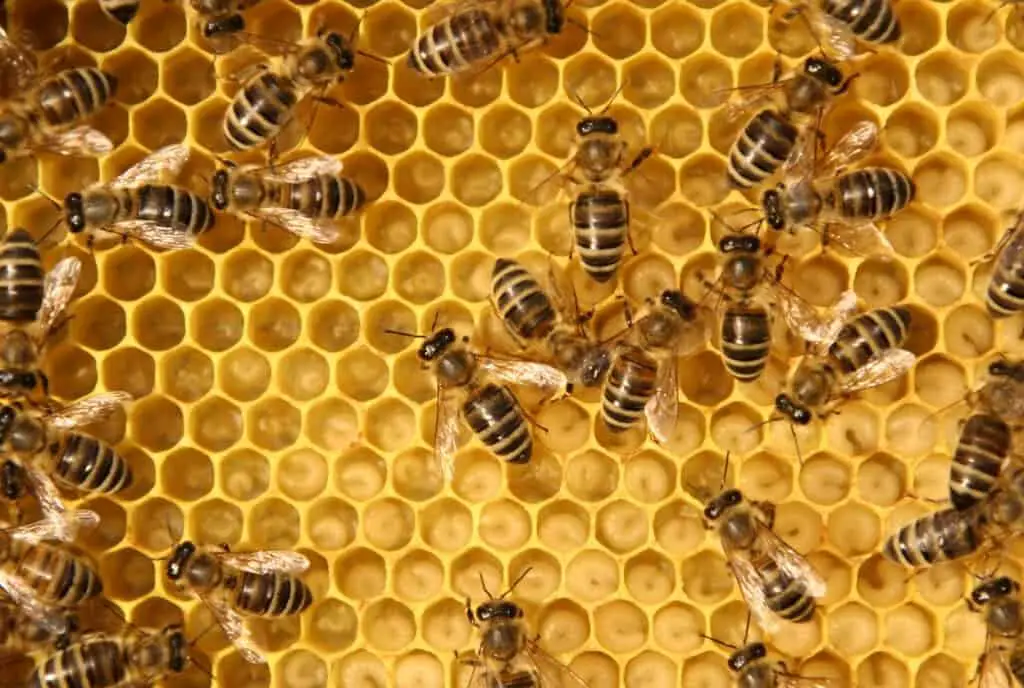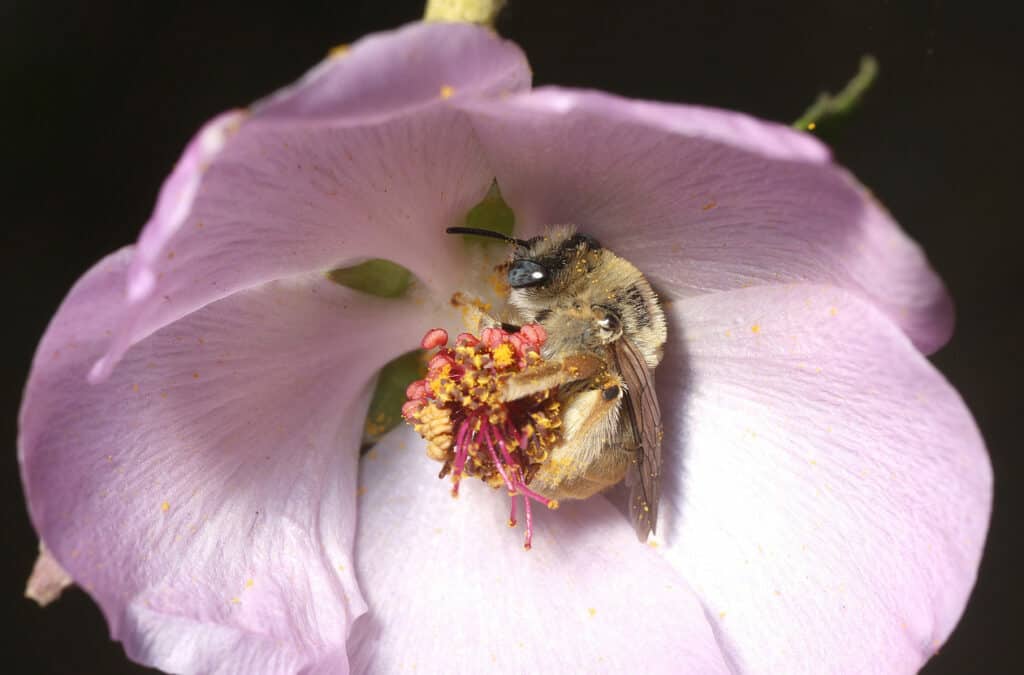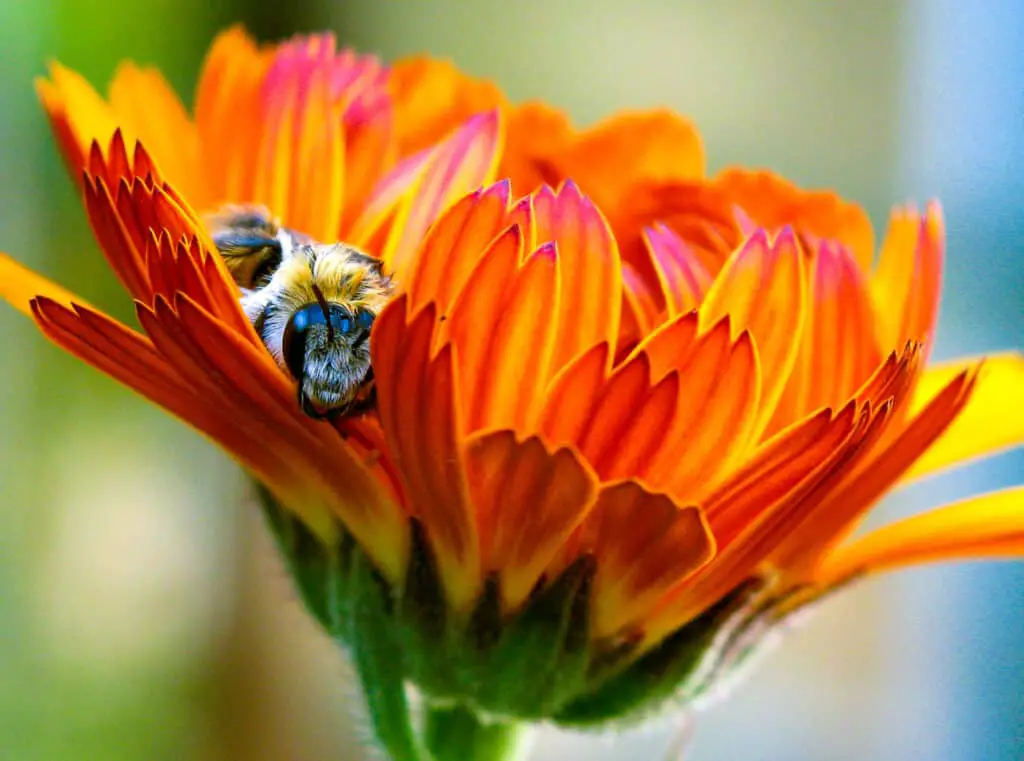During the summer months, I am continually fascinated by the little bees as they buzz from one flower to the next, collecting nectar and pollen for their nest. These energetic creatures are always so busy and on the go. And I often wonder, do bees sleep?
Bees do sleep, as established by researcher Walter Keiser in 1983. Their muscle tone and mobility decrease, and they have lower body temperature. Some bees sleep at night, and others take naps during the day. Bees sleep in hives, nestle in flowers, or hang from a stalk.
How do you know if a bee is sleeping, and where do they sleep? How long do they sleep, and why do bees need sleep? Read on for more interesting facts about the sleeping patterns of bees.
Bees And Sleep

Not so long ago, in 1983, a researcher, Walter Kaiser, established that honeybees do sleep. He noted that these forager bees had decreased muscle tone and mobility, their body temperature was lower, and they needed stimuli to become alert. This pattern was the same for humans, mammals, and birds in deep sleep.
Other bees like bumblebees and solitary bees also follow the same pattern, and it is established that they too sleep, usually during the night.
How Do You Know If A Bee Is Sleeping?

Because bees do not close their eyes, you must look for other signs to see if they are sleeping. Like sleeping children, who need rest after a busy and energetic day, the little bees will tuck in their heads and tails, rest their wings on their body, and their antennae will become still. Bees sometimes fall on their sides; occasionally, other bees will help keep a fellow bee from falling over.
Where Do Bees Sleep?

If you are hoping to find sleeping bees, then know that different types of bees will sleep in various spaces.
Where Do Honeybees Sleep?
Female Honeybees are hardworking little bees that provide food for the queen and the babies. The older bees that do most of the foraging will sleep longer than the younger bees. Older bees also have a more regular sleep pattern, whereas the younger females will take short naps.
Older female bees will find a resting place on the outside edges of the combs where there is less activity. The younger females will sleep near the center of the hive, where the queen and the brood can be found. Some young worker bees will sleep with their heads resting inside an empty cell.
The male drones live and sleep in the hive during spring and summer. The female bees supply them with food. Drones only leave the nest when they hunt for females with which to mate. If they have not mated by winter, the female bees will evict them from the hive, and they have to fend for themselves. Most will not survive the winter.
Why Do Sleeping Honeybees Hold Each Other’s Legs?
When the honeybee’s legs start to flex, and its head falls to the floor when it is asleep, the bee is sometimes so tired it falls over sideways. To prevent this, the clever bees within the hive hold onto each other’s legs while they sleep.
Where Do Solitary Bees Sleep?
Solitary bees do not belong to a colony as the honeybees do. Female solitary bees make their own nests and sleep there during the night or if they need to rest during the day.
Male solitary bees do not have a nest to go home to, so you will find them sleeping anywhere they can find shelter. You will sometimes see them sleeping in the flowers they feed off or clinging to a stalk.
Where Do Bumblebees Sleep?
The large but gentle bumblebee female will sleep inside the nest where she helps to raise the young and look after the queen. Should she not be able to return to the nest before nightfall or if it is raining, she will find a safe place to sleep or rest and will sleep in the flowers or on stalks.
The male bumblebee does not have a nest to go to, so he will sleep outside at night. He will often snuggle into a flower or bite onto the stem of a stalk. Here he will sleep till morning.
How Long Do Bees Sleep?
Solitary bees and Bumblebees take short naps during the day if needed but will mostly sleep at night when it becomes too dark for them to find food. If not disturbed, they will sleep through the night and awaken in the morning to start their working day.
The young Bumblebee queen will spend an average of 10 to 20 minutes on the ground between flights while looking for food for her first brood. She could be taking a nap or just resting. Once she has raised her first batch of females, she will stay in her nest and sleep whenever she can between her egg-laying duties. The young females will take over her outside foraging responsibilities.
How Long Do Female Honeybees Sleep?
Honeybees that live in hives within a colony have sleep patterns according to their work schedule. The young female workers are the house bees who care for the queen, clean the hive, and look after the developing brood. Because they work both day and night within the hive, they will take short naps whenever they can.
The older bees are the forager bees that fly in and out of the hive seeking food to bring back to the colony. They are very active during the day, sleeping predominantly at night but taking short naps during the day. These forager bees have much longer sleep naps than the younger house bees.
Forager bees will sleep deeply at night, awaken in the morning and start their day by working outside the hive. During the day, you might see these older bees having a quick nap inside the flowers before they continue gathering food for the hive.
In hours, female honeybees sleep between 5 and 8 hours a day. But unlike humans who take continuous hours of sleep, honeybees take several short naps within a 24-hour period. It is estimated that the young females take about 40 naps whenever possible, and the older bees take 50 naps mostly at night.
How Long Do Male Honeybees Sleep?
The male drone bees will sleep at night in the hive, wake in the morning, and feed on the honey supplied by the females. Drones will leave the hive in mating swarms searching for females to mate with. They will return after a few hours to rest and feed.
How Long Does A Queen Honeybee Sleep?
The Queen bee will sleep at night if she has completed her daily tasks and will awake in the morning and begin her work of laying eggs.
Why Do Bees Need Sleep?
A honeybee colony needs food to survive. The older forager bees play a huge part in keeping the colony healthy and viable by collecting food to take back to the hive. But this is not their only task. They also play a huge part in communicating where the best food sources can be found to other bees. They will do their waggle dance as they map out a floral route for other foragers to follow.
Just like humans who are not at their most productive if sleep deprived, these forager bees also need sleep to perform at their best. Bees form memories from their daily activities. They record the routes to and from the hive and where to find the best food. When bees do not get enough sleep, they will forget, have more difficulty finding their way home, and often get lost.
The young female workers tending the hive also need sleep to perform their house duties. These busy bees take short naps throughout the day and night to replenish their energy.
Solitary bees and honeybees need sleep to be productive in their search for food. The young female queens need their sleep to be able to build their nests and look after their brood.
How Do Bees Wake Up From Their Sleep?
Bees that sleep outside at night are naturally awakened when the sun rises in the sky. But when bees are in a deep sleep, it does take a while for them to wake up.
Bees that sleep within a colony amongst other bees have different stimuli to awaken them from sleep. The bees will use a type of vibration (Dorso-Ventral Abdominal Vibration) caused by the bee’s rapid movement on the comb or on another bee. This vibration will awaken the forager bees, and they will slowly become active.
Do Bees Sleep Through Winter?
Different types of bees will react differently during the winter months.
Do Honeybees Sleep Through Winter?
Honeybees do not hibernate or sleep through winter. Only the females and the queen bees remain in the hive. They form a tight winter cluster where they huddle together with the queen at the warmest spot. Bees will cluster when the temperature drops to 50 to 57°F (10 to 14°C).
The bees will shake and shiver together to maintain a survivable heat. They will crawl and move around in the cluster to reach the reserves of honey to feed. The bees will take turns sleeping while in the cluster to ensure that those that are awake will continue to make heat.
Do Bumblebees Sleep Through Winter?
Only the young queen bumblebee is left to survive the winter. The old queen and other bumblebees will die before the cold sets in. The young queen bumblebee will hibernate during the winter and will neither eat nor work.
Her metabolism goes into a depressed rate which allows her to live for long periods while using up very little fuel. During the cold season, you will find the queen bumblebee in a deep sleep within nooks and crannies under the ground.
Do Solitary Bees Sleep Through Winter?
In the winter, only the young, fully formed adults are left. They will hibernate and stay in their cocoons during the cold season (e.g., Mason bees). Or the young might still be in their pupae stage and will also hibernate throughout the winter (e.g., Leaf-cutting bees). These bees will emerge from their cocoons or burrows when spring arrives.
Does Pesticides Have An Impact On The Sleep Cycle Of Bees?
Pesticides (neonicotinoids) are applied to crops to protect the growing plants from critters. Bees often forage near these crops and are caught in the crossfire of these pesticides. The chemicals have an influence on the bees’ energy-producing molecules.
Scientists from the University of Bristol tested the effect of pesticides on bumblebees. They found that their natural sleeping patterns were disrupted. The bees were more active at night and slept more during the day. It seemed that the drugged bees were unable to sleep.
This resulted in the bumblebees’ having lower foraging activity, impacting their memories which they rely on for finding their way to and from their nest. The same tests were conducted on fruit flies with similar brain structures to bees. The pesticide had the same effect on the flies. Neonicotinoid pesticides were banned by the EU in 2016, but unfortunately, they are still being used worldwide.
Conclusion
In 1983 it was established that bees do sleep. Some types of bees sleep through the night while others take short naps. Bees will also nap during their busy daytime activities, and you will often find them sleeping in flowers or clinging to a stalk. Just like humans, bees need sleep to be able to be more productive. Sleep is essential for retaining their memories of vital floral routes to and from their hives.
The bumblebee queen and the young solitary bees will hibernate and sleep through winter. In contrast, the honeybee queen and her female worker bees will remain in their hive during the cold season. They will produce enough heat by forming a cluster to survive until the spring. Honeybees will take turns to nap and sleep during this time.
References
https://www.buzzaboutbees.net/do-bees-sleep.html
https://newatlas.com/environment/common-pesticide-sleep-cycle-bees/
https://www.britannica.com/story/where-do-honeybees-go-in-the-winter

